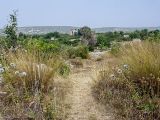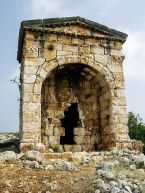About 13 km east of Kızkalesi, near the village of Kumkuyu, lies the site of the ancient city of Kanytelis (Kanytellis, Kanytelleis, Canytelis) known today as Kanlıdivane, which literally means bloody crazy.
Historical Background
At the centre of the Kanlıdivane site is an enormous 60 m deep canyon with red-coloured walls that gave rise to the local legend that says that criminals were once thrown to their deaths into the huge chasm. The 90 m long by 70 m wide and 60 m deep chasm formed the core of the ancient city of Kanytellis. Kanytellis originally was part of the ancient Kingdom of Olba and the sinkhole was regarded as a sacred place reserved to the cult of Zeus Olbios. The first settlement began in the holy chasm for many hundred years before Christ and then gradually extended in all directions during the following centuries. Kanytellis thrived through Byzantine times as is indicated by the presence of several Byzantine churches and inscriptions.
Sights & Photos of Kanlıdivane
Among the highlights of the archaeological site, there is the Tower of Zeus Olbios, the Armaronxas Family's Relief, the Church of Papylos, and the temple tomb mausoleum. The tower was dedicated to Zeus Olbios in 200 BCE by the Olbian priest-king Teukros, son of Tarkyares. The relief of the Amaronxas Family is carved in a rectangular niche (4 x 2 m) into the rock wall of the holy chasm, beneath the tower of Zeus. It dates back from the Roman period and depicts a funeral meal scene of a family of six persons: father, mother, a son, and three daughters.
The Church of Papylos stands at the northern end of the chasm. The church was built as a vow by a religious person named Papylos. An inscription above the main entrance reads as follows: This is the door leading to God. Those who enter, are saved. God help me. The temple tomb mausoleum was built by a Canytelian lady named Aba as a memorial for her husband and two sons, who were probably victims of the plague.
The presence of a holy tree on the site shows that the locals still consider Kanlıdivane as some kind of mystical place.
A shallow gorge at about 300 m west of the city contains the Roman necropolis of the 1st century CE with many graves built in the form of miniature temples. The rock-cut family tombs are decorated with human reliefs and inscriptions.
https://www.turkeyphotoguide.com/kanlidivane?tmpl=component&print=1#sigProId15efb38308






















